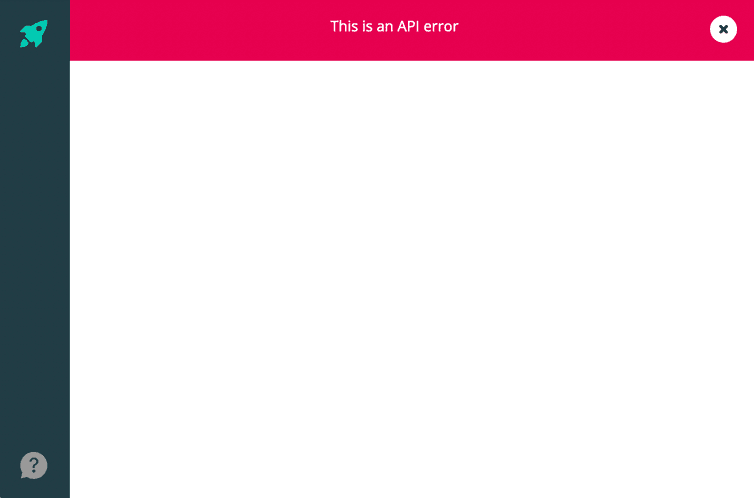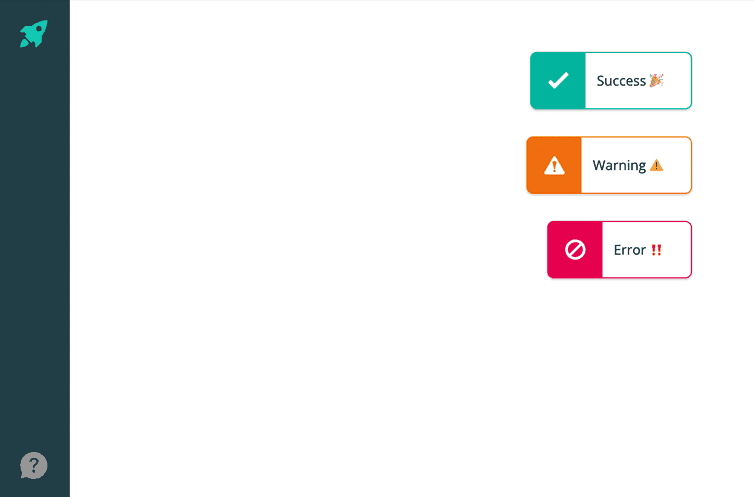This is the early access documentation preview for Custom Views. This documentation might not be in sync with our official documentation.
Notifications
In the previous section, we learned how to develop forms. In this section, we'll look at how to provide feedback to users using notifications, especially in response to user actions.
To facilitate the use of notifications, Custom Applications have a built-in notification system.
Notification system
Notifications are an important means of providing feedback in response to user actions. For example, the submission of a form may succeed or fail. The user should be informed about this in an understandable and easy-to-find way.
Notifications are grouped by so-called domains. A domain specifies where the notification should be displayed on the page (for instance page and side).
Various types of notifications are available: success, error, warning, info. Depending on the use case you choose the appropriate type. For example, if a form was submitted successfully, you would display a side notification of the type success.
Triggering notifications is done using some custom React hooks. Please refer to the @commercetools-frontend/actions-global package for implementation details.
For defining the domain and the kind of a notification, we recommend using the values exposed from @commercetools-frontend/constants.
For example:
import { useShowNotification } from '@commercetools-frontend/actions-global';import {DOMAINS,NOTIFICATION_KINDS_SIDE,NOTIFICATION_KINDS_PAGE,} from '@commercetools-frontend/constants';const showNotification = useShowNotification();// success notification in side domainshowNotification({kind: NOTIFICATION_KINDS_SIDE.success,domain: DOMAINS.SIDE,text: 'Success 🎉',});// warning notification in page domainshowNotification({kind: NOTIFICATION_KINDS_PAGE.warning,domain: DOMAINS.PAGE,text: 'Warning ⚠️',});
Be mindful of Custom Application users convenience when dispatching notifications. Excessive and confusing notifications may lead to poor user experience.
Page notifications
Page notifications are displayed on top of the content page. By default, they must be closed manually.
Generally error notifications should be displayed in the page domain rather than the side domain.
For defining the kind of page notification, we recommend using the NOTIFICATION_KINDS_PAGE constant exposed from @commercetools-frontend/constants.
The available values defined by the constant are error, warning, info, success, unexpected-error and api-error.
Side notifications
Side notifications are smaller than page notifications and they slide in from the right side of the page.
Success notifications in the side domain by default disappear after 5 seconds.
We recommend displaying success notifications in the side domain.
For defining the kind of side notification we recommend using NOTIFICATION_KINDS_SIDE constant exposed from @commercetools-frontend/constants.
The available values defined by the constant are error, warning, info and success.
Using notifications in a form
Let's implement notifications in the details page of the Channels application.
Form submitted successfully
import { useCallback } from 'react';import { useRouteMatch } from 'react-router-dom';import { useApplicationContext } from '@commercetools-frontend/application-shell-connectors';import { FormModalPage } from '@commercetools-frontend/application-components';import LoadingSpinner from '@commercetools-uikit/loading-spinner';import { useShowNotification } from '@commercetools-frontend/actions-global';import {DOMAINS,NOTIFICATION_KINDS_SIDE,} from '@commercetools-frontend/constants';import useChannelsFetcher from './use-channels-fetcher';import useChannelsUpdater from './use-channels-updater';import { docToFormValues, formValuesToDoc } from './conversions';import ChannelsForm from './channels-form';const ChannelsDetails = (props) => {const match = useRouteMatch();const languages = useApplicationContext((context) => context.project.languages);const { data: channel } = useChannelsFetcher(match.params.id);const { updateChannel } = useChannelsUpdater(match.params.id);const showNotification = useShowNotification();const handleSubmit = useCallback(async (formValues) => {const data = formValuesToDoc(formValues);try {await updateChannel(data);showNotification({kind: NOTIFICATION_KINDS_SIDE.success,domain: DOMAINS.SIDE,text: 'Channel updated! 🎉',});} catch (graphQLErrors) {// show an error notification}},[showNotification, updateChannel]);if (!channel) {return <LoadingSpinner />;}return (<ChannelsForminitialValues={docToFormValues(channel, languages)}onSubmit={handleSubmit}>{(formProps) => {return (<FormModalPagetitle="Manage Channel"isOpenonClose={props.onClose}isPrimaryButtonDisabled={formProps.isSubmitting}onSecondaryButtonClick={formProps.handleCancel}onPrimaryButtonClick={formProps.submitForm}>{formProps.formElements}</FormModalPage>);}}</ChannelsForm>);};
Form submitted with errors
In most cases, displaying error notifications is the result of handling API errors. For example, submitting a form is rejected by the API. In this section, we will look at some examples of API error handling for GraphQL and REST API requests.
GraphQL
Find more information about GraphQL errors in the Apollo Client docs.
The basic implementation of dispatching error notifications in the Channels application might look like this:
// ...import { useShowApiErrorNotification } from '@commercetools-frontend/actions-global';const ChannelsDetails = (props) => {// ...const showApiErrorNotification = useShowApiErrorNotification();const handleSubmit = useCallback(async (formValues) => {const data = formValuesToDoc(formValues);try {// ...} catch (graphQLErrors) {const errors = Array.isArray(graphQLErrors)? graphQLErrors: [graphQLErrors];if (errors.length > 0)showApiErrorNotification({errors,});}},[showApiErrorNotification /* ... */]);// ...};
Following our recommendations, not all GraphQL errors should lead to dispatching an error notification. For example, instead of displaying an error notification, we can try to map specific errors to their related form fields.
In the following code snippet, we take advantage of the fact that a Channel's key value must be unique.
A request to update the Channel's key to a duplicated value results in an error with the DuplicateField error code.
Find more information about API errors on the API errors page.
For this purpose, we recommend creating an error transforming function:
import omitEmpty from 'omit-empty-es';const DUPLICATE_FIELD_ERROR_CODE = 'DuplicateField'; // A particular error code returned by API that we wish to map to form field validation errorexport const transformErrors = (graphQlErrors) => {const errorsToMap = Array.isArray(graphQlErrors)? graphQlErrors: [graphQlErrors];const { formErrors, unmappedErrors } = errorsToMap.reduce((transformedErrors, graphQlError) => {const errorCode = graphQlError?.extensions?.code ?? graphQlError.code;const fieldName = graphQlError?.extensions?.field ?? graphQlError.field;if (errorCode === DUPLICATE_FIELD_ERROR_CODE) {transformedErrors.formErrors[fieldName] = { duplicate: true };} else {transformedErrors.unmappedErrors.push(graphQlError);}return transformedErrors;},{formErrors: {}, // will be mappped to form field error messagesunmappedErrors: [], // will result in dispatching `showApiErrorNotification`});return {formErrors: omitEmpty(formErrors),unmappedErrors,};};
In the form onSubmit handler we can then transform the errors, render them in the form (if needed) and dispatch an error notification.
// ...import { transformErrors } from './transform-errors';const ChannelsDetails = (props) => {// ...const handleSubmit = useCallback(async (formValues, formikHelpers) => {const data = formValuesToDoc(formValues);try {// ...} catch (graphQLErrors) {const transformedErrors = transformErrors(graphQLErrors);if (transformedErrors.unmappedErrors.length > 0)showApiErrorNotification({errors: transformedErrors.unmappedErrors,});formikHelpers.setErrors(transformedErrors.formErrors);}},[/* ... */]);// ...};
Now DuplicateField errors related to the key field will be transformed to form validation errors and all other errors to API error notifications.
REST
For HTTP requests sent to REST API we may follow the same pattern as we used for GraphQL:
import { useEffect } from "react";import { useAsyncDispatch, actions } from "@commercetools-frontend/sdk";import { MC_API_PROXY_TARGETS } from "@commercetools-frontend/constants";import {useShowNotification,useShowApiErrorNotification,} from "@commercetools-frontend/actions-global";import { DOMAINS, NOTIFICATION_KINDS_SIDE } from "@commercetools-frontend/constants";const ChannelsDetails = (props) => {const dispatch = useAsyncDispatch();const showNotification = useShowNotification();const showApiErrorNotification = useShowApiErrorNotification();useEffect(() => {async function execute() {try {const result = await dispatch(actions.post({mcApiProxyTarget: MC_API_PROXY_TARGETS.COMMERCETOOLS_PLATFORM,service: "channels",options: { /* ... */ },payload: {// ...},}));// Update state with `result`showNotification({kind: NOTIFICATION_KINDS_SIDE.success,domain: DOMAINS.SIDE,text: "Channel updated! 🎉",});} catch (error) {// Update state with `error`showApiErrorNotification({ errors: error.body?.errors ?? [] });}}execute();}, [dispatch]);return (// ...);};
Usage with React class components
If for some reason a notification must be dispatched from a React class component, we cannot use React hooks exposed from the @commercetools-frontend/actions-global package.
Instead, we should use a Redux action directly.
At a bare minimum, dispatching notifications could look like this:
import { Component } from 'react';import { connect } from 'react-redux';import {showNotification,showApiErrorNotification,} from '@commercetools-frontend/actions-global';import { DOMAINS, NOTIFICATION_KINDS_SIDE } from '@commercetools-frontend/constants';// ...class ChannelsDetails extends Component {handleSubmit = (update) => async (formikValues) => {try {await update(formikValues);this.props.dispatch(showNotification({kind: NOTIFICATION_KINDS_SIDE.success,domain: DOMAINS.SIDE,text: 'Channel updated! 🎉',}));} catch (graphQLErrors) {const errors = Array.isArray(graphQLErrors)? graphQLErrors: [graphQLErrors];if (errors.length > 0) {this.props.dispatch(showApiErrorNotification({errors,}));}}};render() {return (// ...);}}export default connect()(ChannelsDetails);
Testing
We recommend using the test render function renderAppWithRedux when testing notifications, as they rely on Redux.

